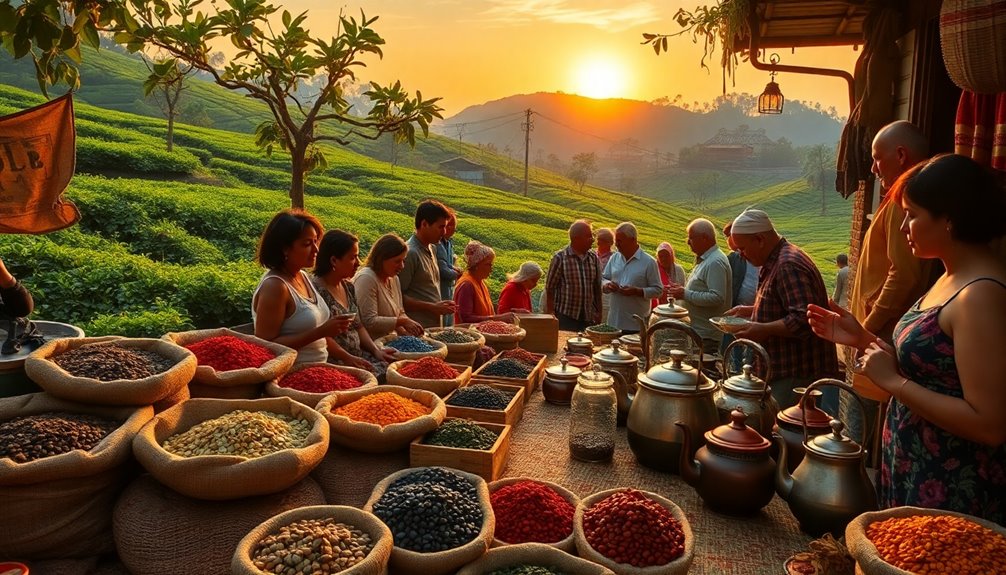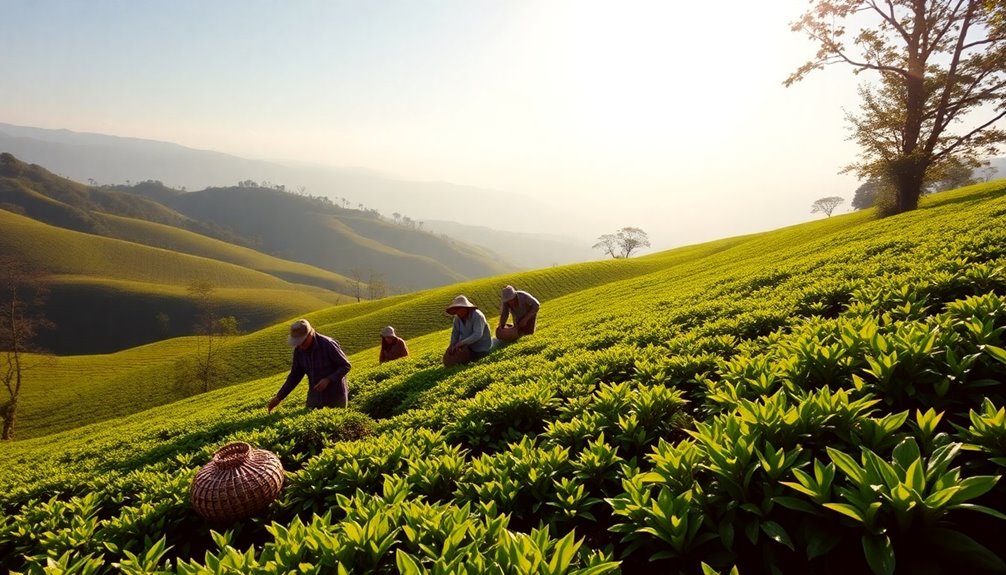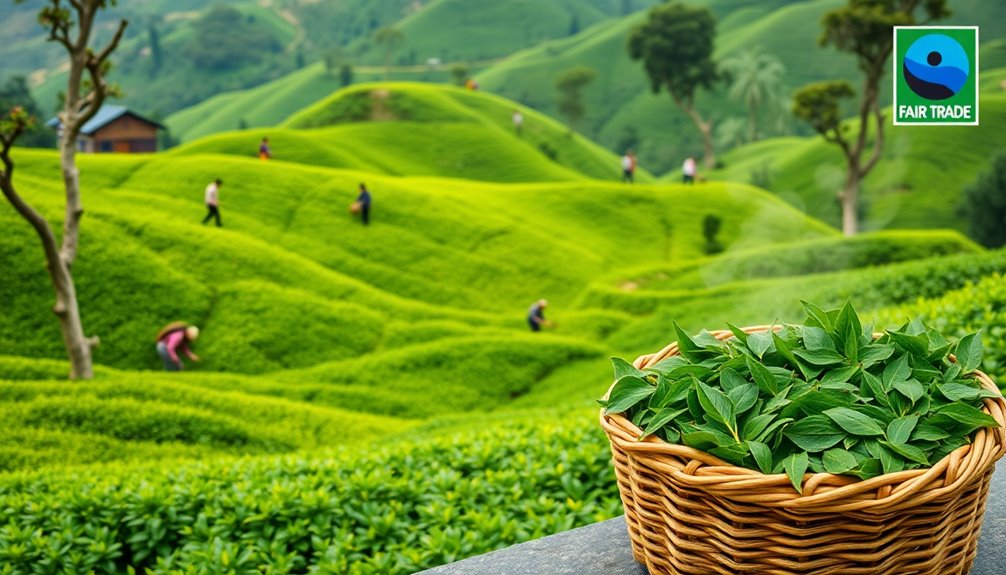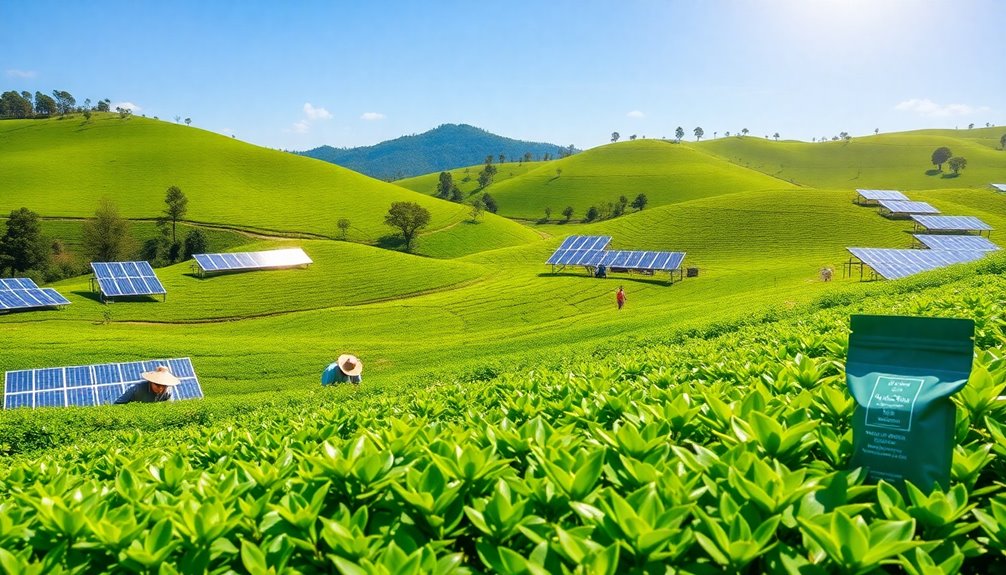Tea's fascinating journey as a global commodity has shaped cultures and economies for centuries! Today, it's worth nearly $99 billion and is projected to reach $182 billion by 2031. You'll find black tea is the most popular, but green and specialty teas are catching on fast, especially among health-conscious folks. Many are choosing tea for its health benefits, like antioxidants that can boost heart health. With a growing interest in sustainable practices and fair labor conditions, the tea industry is changing. There's so much more to discover about tea's history and trends, so let's explore together!
Key Takeaways
- Tea, primarily from Camellia sinensis, has evolved as a global commodity with significant historical value and diverse consumption patterns.
- Black tea dominates production at 58%, while green tea's popularity is rising, reflecting changing consumer preferences and health trends.
- The global tea market is projected to grow from $98.94 billion in 2022 to $181.90 billion by 2031, driven by health-conscious consumers.
- Sustainability and ethical labor practices are becoming critical, with consumers increasingly favoring organic and Fair Trade products amid stagnant pricing.
- The Ready-to-Drink tea segment is expanding rapidly, indicating a shift towards convenient, healthier beverage options among younger generations.
Introduction
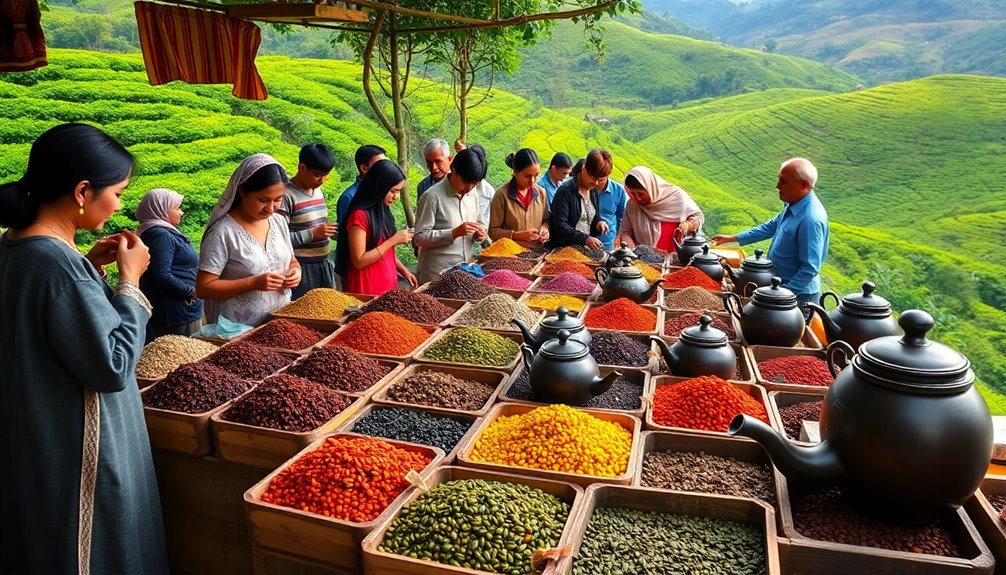
Tea, often seen as a simple beverage, has evolved into a significant global commodity with a fascinating history. You mightn't realize how important tea is in the international trade market! It all starts with the Camellia sinensis plant, which gives us both black tea and green tea.
Black tea is the star, making up 58% of the world's tea production. But green tea is catching up fast, thanks to its many health benefits.
As you explore the tea industry, you'll discover that it's worth nearly $99 billion! And guess what? Experts predict it could grow to about $182 billion by 2031. That's a big jump!
However, the tea market faces some challenges. Climate change can affect how tea grows, and there's competition with other drinks that people enjoy. Plus, with so many specialty teas out there, companies need to find ways to stand out.
In places like India and Sri Lanka, auction centers play a vital role in setting tea prices. This competitive bidding helps keep the market lively and exciting.
Global Tea Consumption Trends
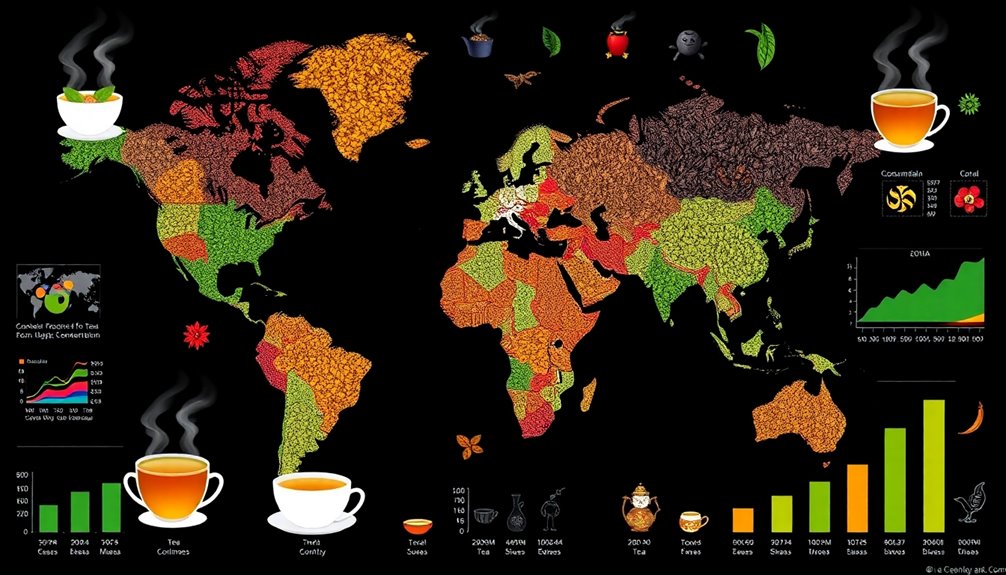
The rising popularity of tea reflects a vibrant shift in global consumption trends, highlighting its importance in modern lifestyles.
You'll find that the global tea market was valued at about USD 98.94 billion in 2022 and is expected to soar to USD 181.90 billion by 2031! Isn't that exciting?
While black tea remains the most consumed variety, green teas are quickly catching up due to their health benefits. More and more people are looking for ways to boost their health, and tea is a tasty choice!
The Ready-to-Drink (RTD) tea segment is also making waves, growing by 7-8% last year alone. This shows that you prefer convenience in your beverages.
You might notice that specialty teas, like organic and artisanal blends, are becoming more popular, too. These unique flavors appeal to health-conscious tea lovers.
With 70% of Gen Z and Millennials planning to keep drinking more tea after COVID, it's clear that health and wellness trends are shaping tea consumption.
Market Growth Driven by Health
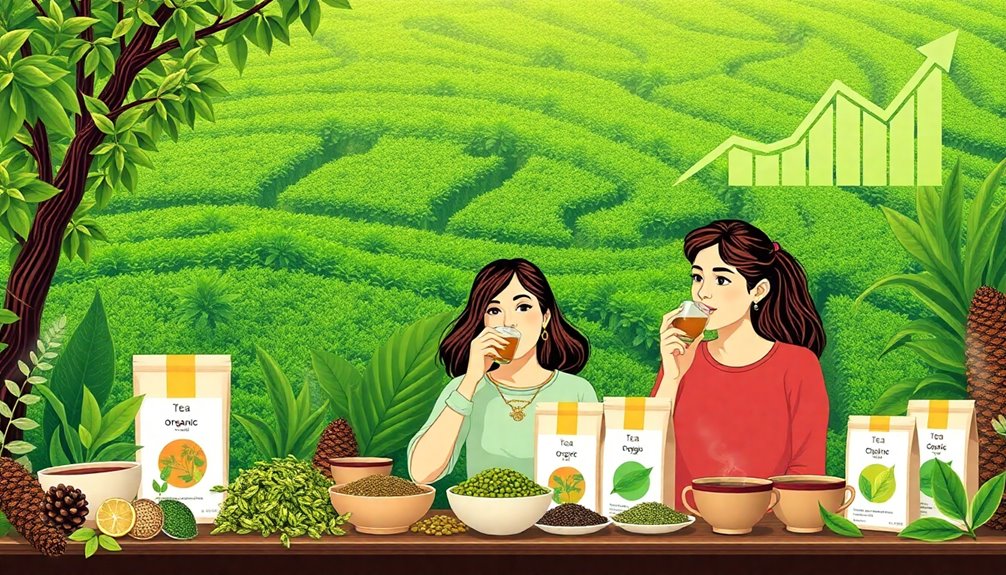
Increasingly, health-conscious consumers are turning to tea as a flavorful alternative to sugary drinks, driving significant market growth. With a global tea market projected to reach USD 181.90 billion by 2031, it's clear that this trend is here to stay.
You might be excited to learn that tea isn't just tasty; it's also packed with health benefits! Many people enjoy the antioxidants in tea, which can help improve heart health and support weight management.
Specialty teas, including herbal and organic varieties, are becoming favorites among those seeking health-promoting options. These unique tea varieties cater to a wide range of tastes and preferences.
Plus, the Ready-to-Drink (RTD) tea segment is booming, growing by 7-8% in 2022! This reflects your desire for convenient, health-oriented beverages that fit your busy lifestyle.
As younger generations embrace tea, they're discovering its amazing potential to reduce the risk of chronic diseases. With so many delicious choices available, you can enjoy a comforting cup of tea while making a positive impact on your well-being.
Sustainability in Tea Production
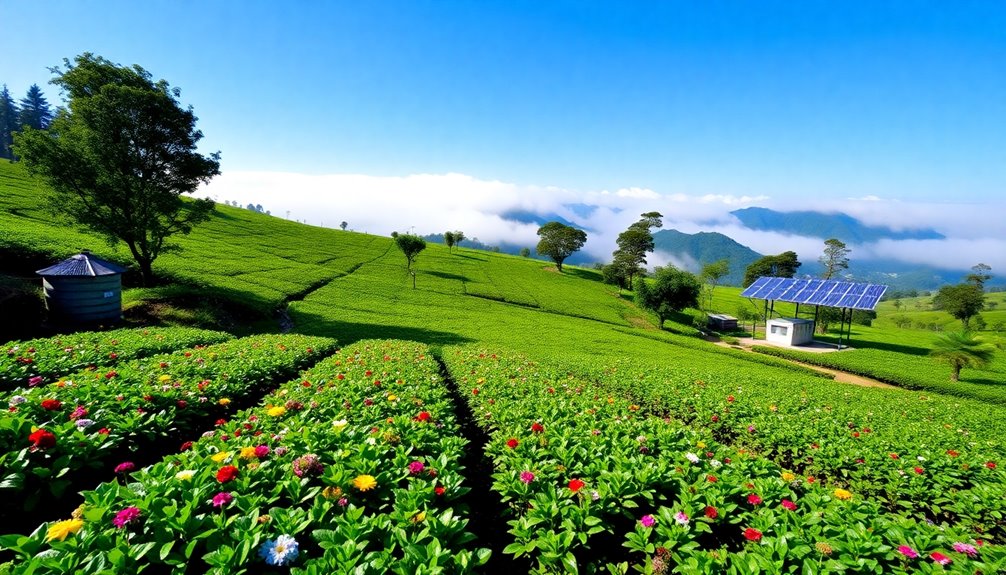
Sustainable tea production is becoming a pressing issue as consumers demand more eco-friendly practices. You mightn't know that the tea industry faces big challenges to become more sustainable. These challenges touch on ecological, social, and economic aspects.
Since tea prices have been stagnant since the 1950s, many producers struggle to keep their farms running. This can lead to fewer workers in tea production as people move to cities for better opportunities.
Increased consumer awareness about sustainability is great, but it shows a gap in how retailers price tea. To truly support sustainable practices, we need better financial support. This is where collaboration comes in!
Producers, packers, and retailers must work together to promote sustainable tea trade. By joining forces, they can create fair pricing and share costs.
Engaging in industry forums and collective actions can help tackle excess supply challenges. Plus, emphasizing the health benefits of tea can encourage more people to choose sustainable options. The growing organic tea market, projected to grow at a CAGR of 5.2% through 2026, reflects this shift towards sustainability.
When you choose sustainably produced tea, you're not just enjoying a delicious beverage; you're also supporting a healthier planet! Let's raise our cups to a brighter, greener future for tea!
Labor Practices in Tea Farming
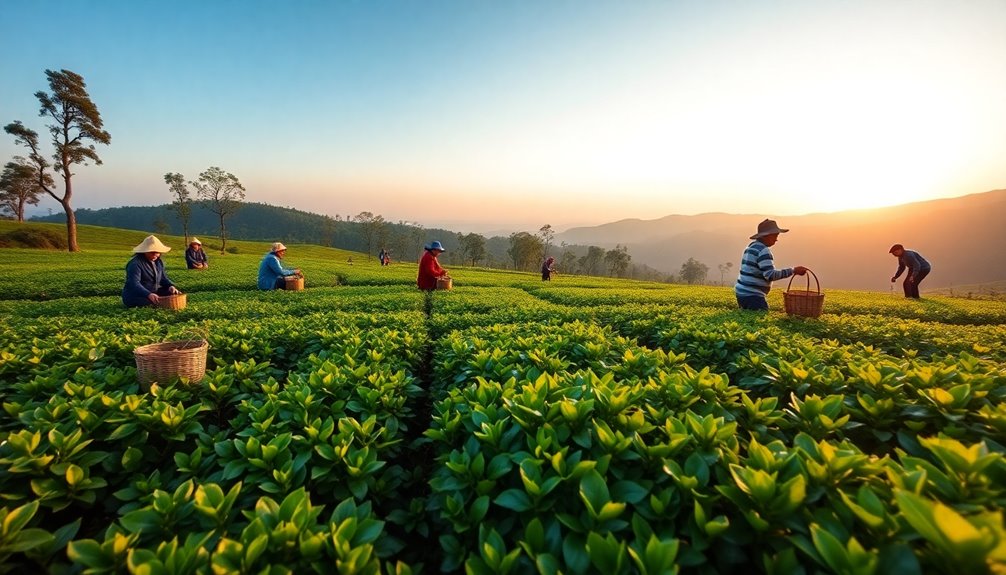
Labor practices in tea farming often raise serious concerns about the welfare of workers. In many countries, especially India and Sri Lanka, smallholders produce around 60% of the world's tea. Unfortunately, these farmers often face tough working conditions. They work long hours for low wages, and their living conditions can be quite poor.
A big problem is child labor. In places like Assam, children help their families earn money, even though it's not safe or fair. This practice needs to change. That's where Fair Trade comes in! Fair Trade aims to ensure that workers get better pay and safer working conditions. It helps promote economic sustainability, so farmers can thrive instead of struggling.
However, many tea farms still rely on unregulated labor practices, which can be harmful. As prices for tea haven't changed much since the 1950s, younger generations often leave tea farming for better opportunities in cities.
We need to encourage better practices in the tea industry so that all workers can enjoy fair treatment and a brighter future. By supporting Fair Trade and choosing ethical brands, you can help make a difference!
Practical Applications
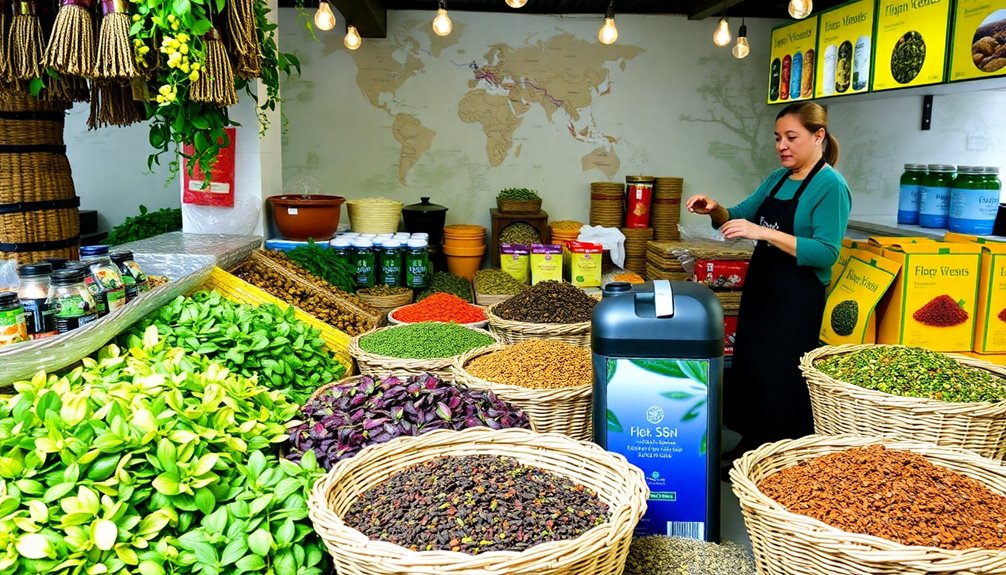
The tea industry presents numerous practical applications that can drive both economic growth and social responsibility. As you explore this vibrant sector, you'll notice that teas, especially black teas, are key players. They dominate the market, particularly in India and Sri Lanka. This makes it exciting for tea manufacturers who want to capture more market share.
You might also be intrigued by the growing interest in specialty teas. Consumers are looking for unique flavors and health benefits, which makes herbal and organic varieties increasingly popular. This shift shows how much people care about what they drink!
Another fun trend is the rise of Ready-to-Drink (RTD) tea. With a 7-8% growth, it's clear that convenience is important to busy folks like you. You can grab a refreshing tea on the go, making it a perfect choice for a quick boost.
Lastly, keep an eye on international trade. As tea prices fluctuate, understanding this market can help you appreciate the delicious beverage in your cup even more.
Embrace the excitement of the tea world, where every sip can lead to new discoveries!
Frequently Asked Questions
When Did Tea Become a Commodity?
Tea became a commodity in the 19th century when British colonial powers established plantations, standardized production, and created auction systems. This transformation paved the way for tea's global trade and recognition as a major commodity.
What Is the Demand Forecasting of Tea?
You're looking at a booming tea market, projected to reach USD 181.90 billion by 2031. Demand's driven by health trends, convenience, and a younger audience embracing specialty and ready-to-drink options. Growth's unstoppable!
What Is the Future of the Tea Industry?
The future of the tea industry looks promising for you. With growing demand for specialty teas, health-conscious choices, and sustainability initiatives, you can expect innovative products and market growth, especially in North America.
What Is the Tea Market Prediction?
You can expect the tea market to grow significantly, reaching USD 181.90 billion by 2031, driven by increasing demand for specialty teas and health-focused products. Black tea remains popular, but green tea's growth is notable.
Conclusion
In conclusion, tea is much more than just a tasty drink! It has a rich history and is loved by people all over the world. As we learn more about its health benefits and how to grow it sustainably, we can enjoy our favorite brews even more. By supporting fair labor practices, we help farmers and their families thrive. So, the next time you sip your tea, remember its journey and the joy it brings to many!

